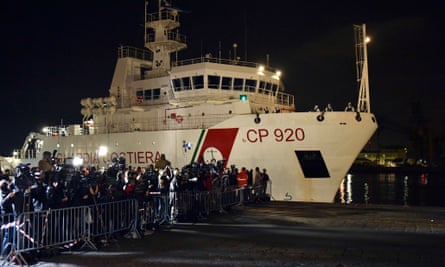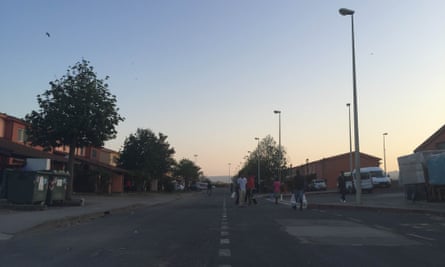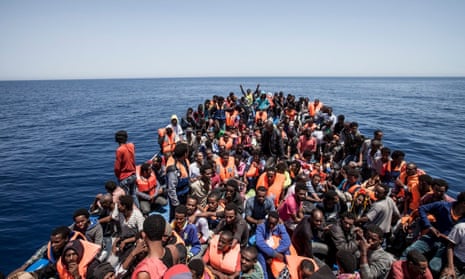When more than 800 people drowned last month in the Mediterranean’s worst modern shipwreck, Ibrahim Mbalo almost joined the dead at the bottom of the sea.
As the boat began to sink below the surface, Mbalo, a 20-year-old Gambian labourer, was trapped underwater below decks, unable to escape. When the water gushed in, another drowning man had pulled him by his trousers towards the bottom of the flooded cabin, which was now essentially a massive water tank filled with flailing men. Mbalo was stuck.
“Will I die?” he thought as he was dragged downwards. “Or will I survive?”
Through extraordinary perseverance and luck, Mbalo achieved the latter – one of just 28 young men to make it out alive. In exclusive interviews with the Guardian, three of them have for the first time given lengthy accounts of their ordeal. Their testimonies constitute the most detailed public record yet of both the disaster and the lives of its protagonists.
Samba Kamar, 20, hadn’t even wanted to be on the boat in the first place. He had left home in Mali in 2013 after family differences, and then civil war, made life untenable. He worked his way north to Libya over the course of a couple of months, paying different smugglers to drive him in packed cars through the desert. At each way-station on the route, Kamar worked as a labourer to pay for the next leg of the journey. He almost died of thirst in the desert south of Libya after his smuggler’s car broke down and left them stranded for days. He was beaten and robbed in Sabha, southern Libya, before arriving in Tripoli near the end of 2013.
For a year, Kamar worked as a labourer for a wealthy Libyan. Sometimes the man would pay him 100 dinars (about £50) for a month’s work, but usually he wouldn’t. By the end of February 2015, Kamar hadn’t been paid for four months. Enough was enough, and Kamar told his boss he wanted his money so he could pay for the trip back to Mali. But instead of paying Kamar in cash, the man said he’d simply pay for the trip directly, and handed Kamar directly to a smuggler.
“I thought I was going to Mali,” Kamar remembered. “But he took me in a car for about 50km and he left me in a place where there were people like me.” Kamar recognised one of them: it was his 17-year-old half-brother Yamadou, who had arrived separately in Libya.

By Kamar’s account, he, Yamadou and their fellow prisoners were held under duress in a cramped house for a month and 18 days. “Then some armed people showed up and said: ‘You have to go on a boat.’”
Omar Diawara, a 23-year-old from Mali, has a similar story. He left home because of the war, with the idea of going to Libya to earn enough money to continue his education once tensions had subsided in Bamako, Mali’s capital. Once in Tripoli, Diawara worked as a day-labourer until two men approached him in the street and offered him a job. He got into their car – and they kidnapped him.
He was held on his own for six weeks as his kidnappers tried to extract a ransom. “They asked me for money,” Diawara said. “They asked me to call my family but I don’t have any parents. And then they realised I didn’t have any money.”
He briefly escaped, but three days later was caught again by the same gang. This time they locked him in a house near the sea. “I spent a month and two weeks there,” Diawara says. “Then one night they told me to board a small rubber boat.”
Of the three, Mbalo was the only one who had wanted to go to Europe – and even then it was not his first choice. He arrived in Tripoli last September, after a six-month stop-start odyssey from his Gambian home on Banjul Island. In happier times, he spent his weekends swimming in the sea. But after his father stopped working and could no longer pay for his education, Mbalo dropped out of school and went to Libya to make money.

Unlike many African migrants in Libya, Mbalo found work with a man who paid him a daily wage, and treated him with relative respect. But even then, Mbalo found Libya a nightmare: it is a country in the throes of a civil war. So after a few months he told his boss he wanted to leave. He would have returned home if he could. But having experienced the trauma of the desert journey once on the way up, Mbalo wasn’t keen to try it again. “If you’re going to the Gambia, maybe the smugglers will take you in the desert and throw you there to die,” Mbalo says. “That’s why a lot of people won’t go back.”
Instead, Mbalo’s boss, Moussa, drove him to Garabulli, a known smuggling hub on the Libyan coast that lies east of Tripoli. There, Moussa paid a smuggler 700 dinar (about £350) to put Mbalo on a boat. And then, like the others, Mbalo was taken to a holding house, where he was shoved in a room already packed with fellow migrants. There by chance he was reunited with his friend Haroun, with whom he had shared the journey north from the Gambia. One night two weeks later, they finally made the short drive to the sea. Or, as Mbalo calls it, the river.
On the beach, Mbalo, Diawara and Kamar found hundreds of other migrants waiting in the darkness. There were those from west Africa – Senegal, Sierra Leone and Mali – and those from the east: Somalia and Eritrea. Some were even from as far away as Bangladesh. What they paid differed from migrant to migrant, depending on how much smugglers had thought they could afford. A few paid as much as 7,000 dinars (about £3,500). Diawara paid nothing, for reasons that remain unclear.
Armed with guns, the smugglers divided them up into about eight or nine groups of up to 100 migrants each. And then a series of large rubber dinghies arrived.
Mbalo was frightened. “Either I will die,” he thought, “or I will go to Italy. Or [Libyan coastguards] will arrest me and take me to prison, and I will pay 500 dinar to get out.”

Each group was herded on to a separate dinghy, and told on pain of death to remain seated. According to Italian prosecutors, one man who did stand up was thrown by smugglers into the sea to drown. Each boat took 20 minutes to reach a larger ship moored a mile or so out to sea. The overwhelming majority of ships that go from Libya to Italy are wooden fishing sloops or inflatable dinghies. This one was a huge steel-hulled merchant ship.
The loading of the ship took several hours, and lasted until the small hours of the following morning. Armed men directed each migrant to a specific place on the boat, so that its cargo was equally spread. The survivors’ descriptions of the boat’s layout do not completely align, but they believe there were at least three levels: one at the bottom next to the engine, a second in the middle with windows, and a third at the top that was outdoors.
Diawara was placed on the deck outside, at the bow of the green ship. Kamar was shoved into the middle level. And Mbalo was forced down to the very bottom.
The heat of the engine made the experience unbearable. But the armed smugglers arranging the rows of migrants would not let Mbalo move. “I couldn’t go out,” he said. “If I’d tried, they would have killed me.”
Upstairs, life wasn’t much better for Kamar. “As soon as I got on the boat I fell ill,” he said. “I felt dizzy because the boat was tilting from side.” And he wasn’t the only one – all around him people were feeling sea sick. “I was vomiting, there were a lot of people vomiting.”
Eventually, not long before dawn, most of the smugglers disembarked. According to Italian prosecutors, they left only a Tunisian – Mohammed Ali Malek – to steer the ship, and a Syrian, Mahmoud Bikhit, to act as his mate. Later arrested in Italy, Malek stands accused of mass murder, but his lawyer says he was merely a passenger. “He is the last person responsible, not the first,” Malek’s lawyer, Massimo Ferrante, told the Guardian, arguing that the Tunisian was picked out by survivors merely because he has pale skin.
As the boat moved off, Mbalo was now free to move, so he picked his way through the other migrants to the middle level, where he sat next to his friend Haroun. It was a decision that would later help save his life. At around the same time, Kamar also experienced what would turn out to be a life-changing moment. Overcome with nausea, and covered in vomit, he was ushered by those around him to the deck outdoors.
For about 18 hours, the boat headed north without incident. Every so often, Diawara says the Syrian mate would descend from the bridge to the engine room, to check it was still running smoothly. The boat travelled slowly, and by about 11pm on Saturday 18 April, it was still only 17 miles from the Libyan coast, and 130 miles from Lampedusa, the southern-most Italian island.

But boats heading north to Italy don’t always need to reach Italian waters. Sometimes they sail as far as international waters, call Italian coastguards for assistance and wait for the nearest European boat to rescue them. In this case, the coastguards in Rome called for assistance from the closest commercial boat, a Madeiran cargo ship called the King Jacob, a vast vessel 146 metres long. One hundred metres from the migrant boat, its sailors later reported, the King Jacob slowed to a halt.
Over on the smaller boat, Mbalo remembers one of the two crew members then descending to the lower decks. “The big boat is coming,” he told the migrants, reminding them to avoid sudden movements in case they overbalance the boat. “Everybody sit still, and go one by one to the big boat.”
Quite what happened next may never be properly understood. Sitting sea sick on the deck, Kamar was drifting in and out of consciousness, unaware of an impending rescue. Mbalo was below deck, unable to see anything. Diawara was awake and outside, but like everyone else could not see what the captain was doing at the wheel.
What seems clear is that as the migrant boat approached the King Jacob, it suddenly sped up. The reasons why, and how, may ultimately be known only to the man at the wheel. But the result was the mother of all T-bone collisions, as the boat hit the side of the King Jacob. According to Diawara, the boat’s bow swung 90 degrees to the left, until the two ships were parallel. Then it began to capsize. Sitting at the back, Diawara says he suddenly found himself next to the King Jacob. In the seconds before the boat began to keel over, he leapt into the merchant ship. By his account, he never touched the water.
A few metres away, Kamar woke up with a start. All he remembers is the jolt of the crash, and the subsequent chaos. “I didn’t understand anything,” he said. “Somebody told me the boat hit the one in front” – but that was all.
Shocked and nauseous, survival instinct nevertheless kicked in. As the boat began to tip, Kamar grabbed the nearest thing to hand: a bit of rope tied to the ship. For a while he gripped the rope, suspended in mid-air. Then he let himself fall into the sea, and grabbed a piece of passing debris. Bobbing in the water, he was spotted by the King Jacob’s Filipino crew. They threw him a lifeline, and hauled him up the side of the ship – one of 22 men they saved that night.
Trapped inside the hull of the migrants’ boat, Mbalo faced a fate far worse. After the collision, the hundreds stuck with him inside had tried to escape. But with so many people swarming the handful of exits, few made it. Most were still inside as the boat dipped below the surface and the water flooded in. Many couldn’t swim, so they grabbed at whatever was to hand. One man found Mbalo’s trouser leg, and dragged him downwards.
“Will I die?” Mbalo wondered. “Or will I survive?”
Life in the Gambia was what had driven him to this wretched point. But as he struggled beneath the surface, his upbringing was also what saved him. All those weekends in the sea off Banjul Island had made him a strong swimmer, and as a big man with big lungs he had become used to swimming for long periods underwater.
So when his neighbour gripped his leg and wouldn’t let go, Mbalo didn’t panic. He says he unzipped his trousers, wriggled free, ripped off his shirt, pushed through a mass of flailing bodies to the top of the cabin, before forcing his way through an open window and struggling to the surface. And then he gasped.
His friend Haroun had drowned. So had Kamar’s brother, Yamadou. But after being submerged underwater for three or four minutes, Mbalo had survived.

The trauma did not end there. By now the King Jacob was some distance away, and every time Mbalo put in a burst to try to reach it, he felt as if the waves pushed him even farther away. “I tried and tried – and then I saw another boat,” Mbalo said. “I followed that boat. I followed and followed. And then they saw me coming.”
The crew flung him a lifeline, and with his last grains of energy Mbalo gripped it and held on until they tugged him to the deck. He stood up. And then he collapsed.
A month on, he and his fellow survivors face an uncertain fate. They are living in an unlikely setting – a village in a remote Sicilian valley that was built for the families of US sailors working at a nearby naval base. Half a decade ago it was converted into a camp to house asylum seekers like Mbalo. But the streets still have names such as Constitution Avenue and Intrepid Lane.
Whether they can stay has yet to be confirmed, and depends on a lengthy asylum application process. While Diawara waits, he is learning Italian and English. He has a basic phone now, and plays with a language app that teaches him the linguistic basics.
Mbalo has a different goal. “I want to work,” he says. “I can do any type of job. Any type of job, I can do it.” How does he feel to be alive? “I thank God,” he says. “I’m very happy.”
But then he takes off his cheap sunglasses to reveal a pair of bloodshot eyes. He says they’re still red from the sea salt.

Comments (…)
Sign in or create your Guardian account to join the discussion